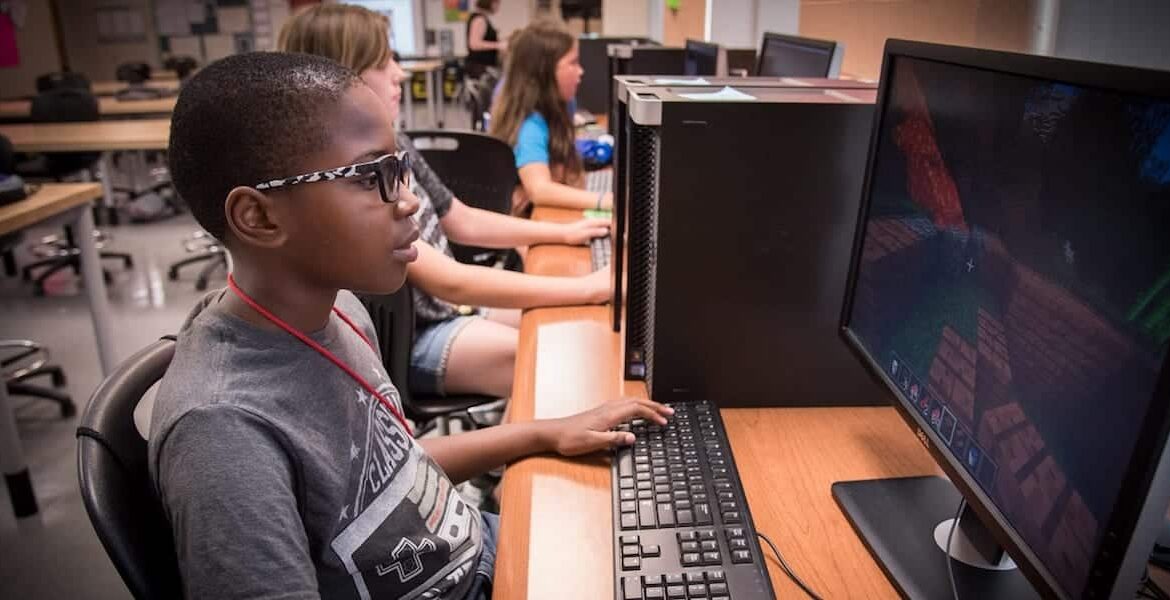Table of Contents
![]() With kids getting smartphones and other devices at younger and younger ages, it’s more important than ever to teach them how to use the internet safely. Whether kids are using social media, searching for information, gaming, or emailing, they should have some basic understanding of how to protect themselves online.
With kids getting smartphones and other devices at younger and younger ages, it’s more important than ever to teach them how to use the internet safely. Whether kids are using social media, searching for information, gaming, or emailing, they should have some basic understanding of how to protect themselves online.
Though teachers and parents are deeply concerned about kids’ online safety, we often don’t know the best ways to teach these skills. And explaining internet safety effectively will vary according to the age group you’re talking to. To help you get started teaching these essential digital citizenship skills in the classroom, we’ve highlighted our favorite lessons for the different grade bands as well as some tips for how to use them.
Younger kids will probably spend less unsupervised time online than those who are older, but it’s never too early to introduce a few smart rules. It’s also easy to do without scaring them!
In “Going Places Safely,” younger elementary schoolers can learn how to think of using the internet as going on a field trip. To stay safe on field trips, kids need to stay with an adult, talk only to people they know, and follow the rules. Ask students which field trips or family outings they’ve been on. Then start a conversation about how fun these trips are and how you can learn new things and go to exciting places. But if kids don’t stay with a grown-up, a field trip can feel a little scary. The same is true when kids are using the internet. Three rules can keep them safe:
- Always talk to your parent or teacher first.
- Talk only to people you know.
- Stick to places that are just right for you.
 Talking Safely Online (Grades 3-5)
Talking Safely Online (Grades 3-5)
In upper elementary school, kids are more used to being online and more likely to be unsupervised and have their own internet-ready devices. They’re also more likely to be asked for private information online. One of the first rules to teach young kids is that they should never give out any personal information online.
One of our lesson plans for upper elementary school students, “Talking Safely Online,” encourages them to think about the difference between online friends and in-person friends. Kids need to understand that it’s hard to know if someone is really who they say they are on the internet. Most kids can relate to pretending to be someone else, such as dressing up for Halloween or a costume party or being in a play. Point out to them that they might not know if someone online is telling the truth about how old they are, what grade they’re in, or their real name, so it’s a good idea to check everything with a grown-up first.
Kids tend to understand that they shouldn’t give information like their full name or their address to strangers in real life. When teaching them about online safety, point out that the same is true for the internet. People online might seem really nice, but they’re still strangers, and kids shouldn’t give them any personal information. If anyone does ask for that information, it’s important to find an adult and tell them.
Safe Online Talk (Grades 6-8)
Bullying has always been a concern in middle school, but that can be exacerbated on the internet. Social media, chat rooms, and other forums for online messaging make kids much more vulnerable to bullying and predatory behavior now than ever before. Internet safety begins when students know how to get out of possibly dangerous situations.
“Safe Online Talk,” one of our lessons for middle schoolers, includes a video called “Perspectives on Chatting Safely Online” that’s an excellent prompt for a class discussion. Teens in the video share personal advice, and your students can talk about what resonates with them and any personal connections that come to mind.
Middle school students can get so caught up in online conversations that they forget they can simply walk away or shut off their devices if things get uncomfortable. It’s a good reminder to suggest that kids step away from a questionable online situation to get some perspective. And if they’re not comfortable talking to a parent about it, they can talk to a teacher, friend, counselor, or someone else to get their read on the situation.
 Risky Online Relationships (Grades 9-12)
Risky Online Relationships (Grades 9-12)
High school students are online all the time — sometimes constantly — and tend to think of themselves as savvy enough to stay safe in the digital world. However, teens can still benefit from tips and guidance on the topic. While the internet can be a valuable place to have discussions, even about sensitive or controversial topics, it can also lead to awkward or inappropriate situations.
One of our lesson plans for high school, “Risky Online Relationships,” points out that the term “online predator” is misleading for many teens, as it implies a frightening stranger who fits a particular stereotype. In reality, many of these predators seem like nice, friendly people at first but may gradually start becoming inappropriate. Anyone chatting with strangers online should always be wary. Also, risky online relationships don’t have to involve strangers; they can involve people teens have initially met offline.
Teens should also understand that photos and conversations they may consider to be private can be shared at any time, so they should think carefully about what they’re posting or sharing online.
The internet is an amazing tool for students and teachers alike, but building students’ awareness of the potential risks and encouraging thoughtful online behavior can help kids stay safe. Starting these conversations early and continuing to have age-appropriate lessons about online safety will go far in helping kids become savvy digital citizens.
For more tips and strategies on how to keep kids safe online, see our video Protect Your Students’ Data and Privacy.
This article originally appeared on Common Sense Education.
Author
 Bronwyn Harris is an author, educator, and editor living in the East Bay. She is originally from Petaluma, California, and earned a bachelor’s of science in psychology from UC Davis, and a multiple subject teaching credential from CSU Sacramento. Bronwyn began her teaching career in 2000 in the most violent neighborhood in Oakland, California, and has since written a book about her experiences: Literally Unbelievable: Stories from an East Oakland Classroom.Bronwyn has written for Teaching Tolerance and AlterNet, among others. She is an avid reader and knitter and uses Common Sense reviews to guide her on movies for her nieces and nephew. You can follow Bronwyn on
Bronwyn Harris is an author, educator, and editor living in the East Bay. She is originally from Petaluma, California, and earned a bachelor’s of science in psychology from UC Davis, and a multiple subject teaching credential from CSU Sacramento. Bronwyn began her teaching career in 2000 in the most violent neighborhood in Oakland, California, and has since written a book about her experiences: Literally Unbelievable: Stories from an East Oakland Classroom.Bronwyn has written for Teaching Tolerance and AlterNet, among others. She is an avid reader and knitter and uses Common Sense reviews to guide her on movies for her nieces and nephew. You can follow Bronwyn on
Common Sense Education helps educators find the best edtech tools, learn best practices for teaching with tech, and equip students with the skills they need to navigate the digital world with confidence. Get free resources including full reviews of digital tools, ready-made lesson plans, videos, webinars, and more at https://www.commonsense.org/education.
Further Reading
- Lebanon Democrat – Homeland Security agent talks internet safety for middle schoolers
- Yakima Herald – Yakima schools teach students about online dangers
- eLearning Inside News – Online Classes for K-12 Students: Is it Working?

 Talking Safely Online (Grades 3-5)
Talking Safely Online (Grades 3-5)